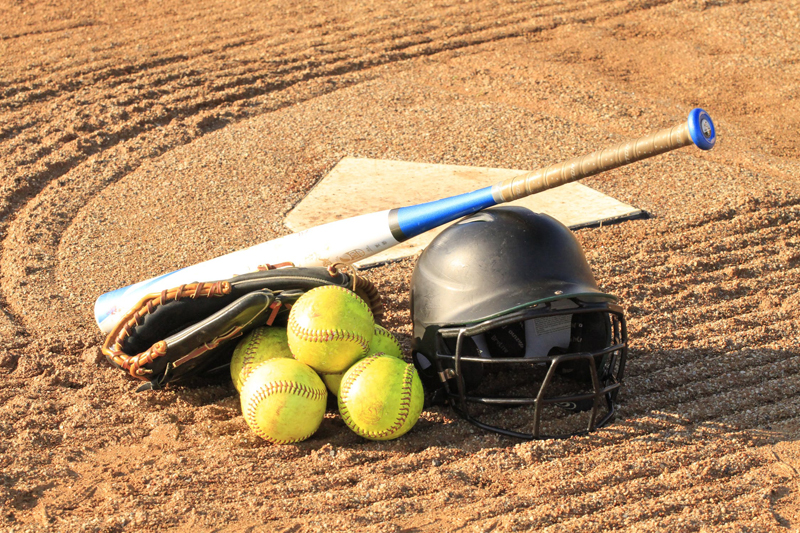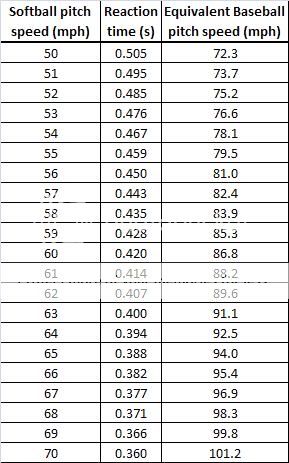Softball vs. Baseball Pitching Speeds

 "Whenever I watch a college or Team USA softball game on TV, inevitably the announcers say something to the effect that a 60 mph fastball in Fast Pitch Softball is the equivalent of a 95 mph fastball in baseball. How do the announcers arrive at that comparison, and are they accurate? This article will aim to answer both questions.
"Whenever I watch a college or Team USA softball game on TV, inevitably the announcers say something to the effect that a 60 mph fastball in Fast Pitch Softball is the equivalent of a 95 mph fastball in baseball. How do the announcers arrive at that comparison, and are they accurate? This article will aim to answer both questions.In comparing Softball pitching to Baseball pitching, it is the batter’s reaction time that has to be determined. For example, at the International and College (and soon to be High School) pitching distance of 43’, a batter facing a 60 mph fastball has about 0.42 seconds to react to the pitch. This reaction time is derived from the fact that Distance = Rate times Time. If we assume that the average Softball pitcher releases the ball about 6 feet (yes, superstars like Jenny Finch have a leg stride closer to 7+ feet, but most pitchers do not) from the rubber, the pitching distance equals 37 feet. It takes a 60 mph fastball 0.42 seconds to travel 37 feet.
To find the equivalent baseball pitch speed, we need to find how fast a ball should be going to cover a baseball pitching distance in 0.42 seconds. A quick Google search indicates that the average baseball pitch stride is between 80% and 90% of a pitcher’s height. For a 6’ 2” pitcher, that equates to a stride distance of about 5.25 feet (assuming 85% of his height). Unlike a Softball pitcher, a Baseball pitcher extends their pitching arm past his body to throw the ball, so we will assume a total release point of 7 feet from the rubber. Therefore, the Baseball pitching distance is 53.5 feet and a ball has to go 86.8 mph to cover that distance in 0.42 seconds.
The table to the right lists equivalent Baseball pitching speeds for corresponding Softball pitching speeds with the above assumptions.
One final note on this topic: most radar guns that are used measure the ball speed as it leaves the pitcher’s hand, whereas this article discusses average speed to the batter. We assume an average speed of 60 mph in the table, knowing that it leaves the pitcher’s hand slightly faster but arrives at the batter slightly slower. I think the “average” approach for speed equivalence is more valid than top-speed-out-of-the-pitcher’s-hand, as the accuracy of a particular radar gun is unknown when it is used.
I usually determine a pitcher’s speed by examining video – from video, I am able to measure the actual distance from the rubber to the release point (if I am side-on to the pitcher), and I can determine the average pitch speed by counting the video frames until the ball reaches the batter. The disadvantage to the video approach is that it is not really a real-time approach, though I can get results in a few minutes if I am set up to do so. A radar gun does provide real-time measurements, which is why telecasts and Major League stadiums use them.
BellaOnline Softball Subject List: Coach´s Box, Health & Medical, History of Softball, International Softball, Organizations, Parents , Professional Softball, Reviews, Rules & Regulations, Scorekeeping, Stats & Analysis, Travel Ball |
This site needs an editor - click to learn more!
You Should Also Read:
Male vs. Female Muscle Mass over Time
Related Articles
Editor's Picks Articles
Top Ten Articles
Previous Features
Site Map
Content copyright © 2023 by Don McKay. All rights reserved.
This content was written by Don McKay. If you wish to use this content in any manner, you need written permission. Contact
BellaOnline Administration
for details.


